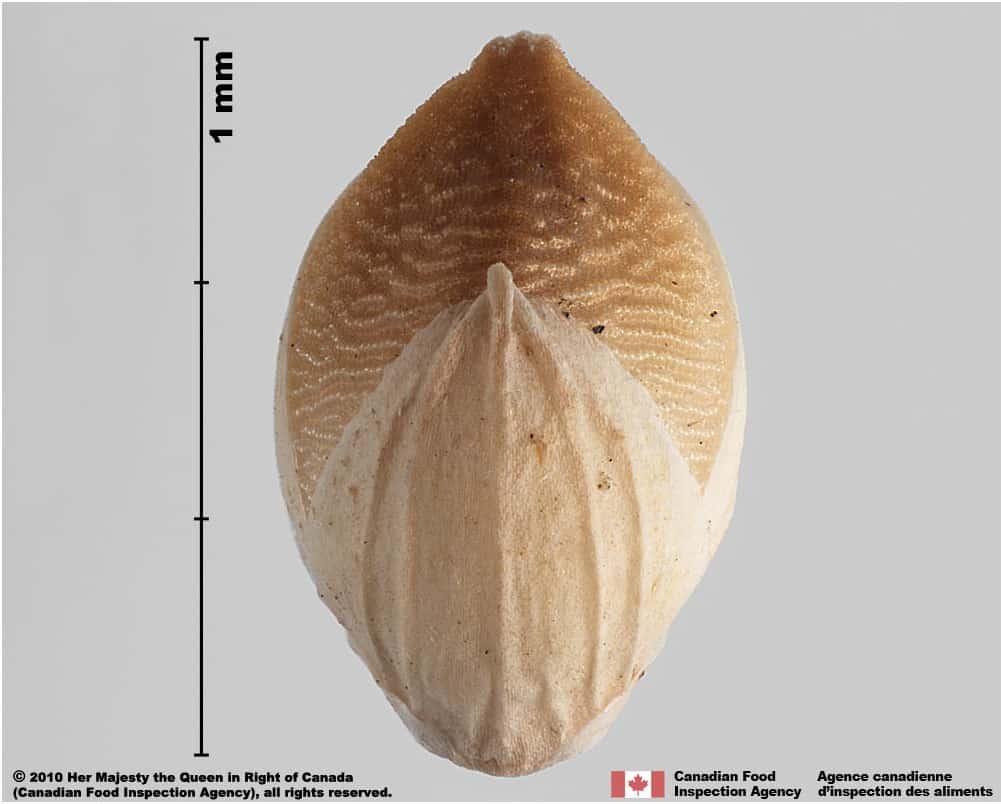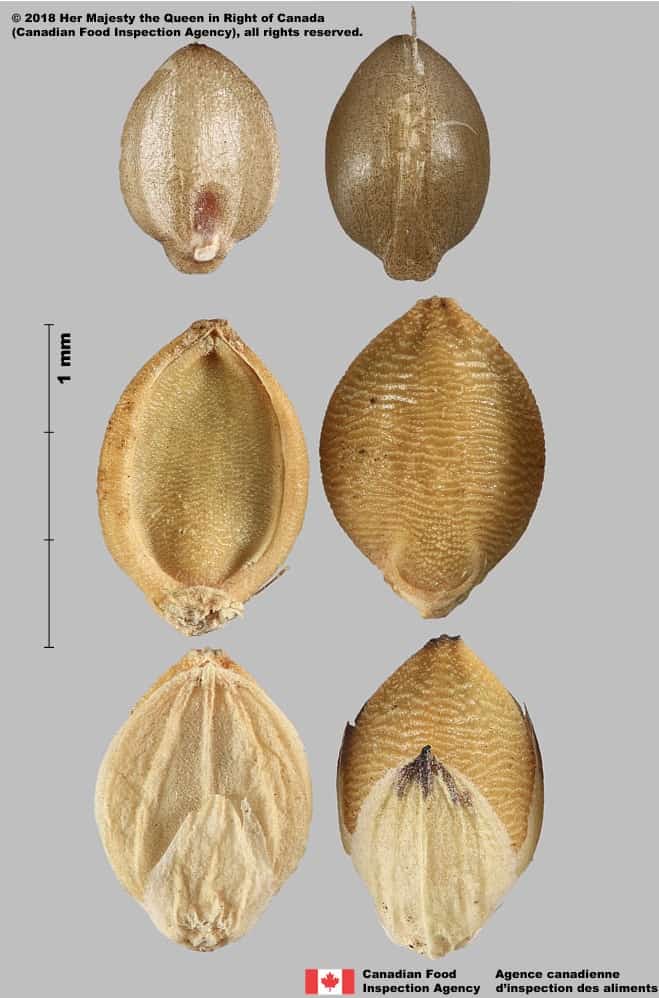Setaria faberi
Overview
Aperçu
Regulation :
Remarques Réglementation:
- CFIA Weed Seeds Order - Class 2: Primary Noxious Weed Seeds
Regulation Notes:
Distribution :
Répartition :
Native to temperate eastern Asia and introduced in North America, central Europe, Russia and the Middle East (Nurse et al. 2009; USDA-ARS 2021). It occurs in the Canadian provinces of British Columbia, Ontario and Quebec (Brouillet et al. 2010+). In the United States, it occurs mostly in the eastern states and is expanding westward (Nurse et al. 2009).
Habitat and Crop Association :
Habitat et Cultures Associées :
Cultivated fields, old fields, gardens, roadsides, railway lines and disturbed areas (Darbyshire 2003). A weed of a variety of crops, but causes the greatest losses in Zea mays (corn) and Glycine max (soybeans) (Nurse et al. 2009; CABI 2021).
Economic Use, cultivation area, and Weed Association :
Utilisation économique, zone de culture et association de mauvaises herbes :
Duration of Life Cycle :
Durée du cycle vital:
Annual
Dispersal Unit Type :
Type d’unité de dispersion :
Spikelet
General Information
RENSEIGNEMENTS GÉNÉRAUX
Setaria faberi may have been introduced into North America as a contaminant of imported seeds from China. It may also contaminate bird seed and flower seed mixtures as well as other crop seeds. In Canada, the occurrence of S. faberi coincided with the cultivation of Zea mays (field corn) beginning in the 1960s (Nurse et al. 2009).
.
Setaria faberi field (John D. Byrd, Mississippi State University, Bugwood.org)
Identification
Identification
-
Spikelet
Size
- Spikelet length*: 2.7 – 3.4 mm; width: 1.3 – 2.0 mm
*Note: minimum and maximum of 10 spikelets in a normal range of this species using image measurement (ISMA 2020)
Shape
- Spikelet egg-shaped, plano-convex in edge view
Surface Texture
- Spikelet has a smooth surface with longitudinal nerves
Colour
- Spikelet colour is dull straw yellow or brown
Other Features
- Glumes and sterile floret are thin and have a papery consistency
- The second glume covers 3/4 of the lemma, the first glume covers up to ¼ of the palea
- The sterile lemma covers the fertile palea of the spikelet
- Sterile palea is thin and pointed, generally adhered to the palea of the fertile floret

Giant foxtail (Setaria faberi) spikelet and florets



-
Floret
Size
- Floret length: 2.8 mm (Barkworth et al. 2003)
Shape
- Florets egg-shaped, plano-convex in 3 dimensions, immature florets are more oval shaped
- Narrow end of lemma curves down in profile view, giving a humped appearance to floret
Surface Texture
- Floret surface is transversely ridged, becoming smooth at the narrow end
- Palea has a grid ridged reticulate texture with smooth edges exposed along the outer edges of the palea
- Immature florets do not have the smooth edges of the palea exposed
Colour
- Floret colour is shiny straw yellow or brown
- Immature florets are light yellow or green coloured
Other Features
- Narrow end of palea dips in towards lemma

Giant foxtail (Setaria faberi) floret, lemma view




-
Caryopsis
Size
- Caryopsis fills the floret
Shape
- Caryopsis is egg-shaped
Surface Texture
- Caryopsis is smooth textured
Colour
- Caryopsis is translucent light yellow coloured
Other Features
- The hilum is round and dark brown coloured, situated on the opposite side of the embryo
-
Embryo
Size
- Embryo is a rudimentary size compared to the caryopsis
Shape
- Embryo is oval or oblong shaped, in a lateral position at one end of the caryopsis
Endosperm
- Endosperm is hard and translucent whitish coloured
Identification Tips
CONSEILS POUR L’IDENTIFICATION
Similar Setaria species can be distinguished by both spikelet and the floret features. The second glume of the S. faberi spikelet generally covers ¾ of the lemma, longer than S. pumila subsp. pumila and shorter than the glume of S. viridis. The lemma texture of similar Setaria species remains rough at the narrow end, but becomes smooth in S. faberi. The humped lemma profile of S. faberi can be distinguished from the evenly curved profiles of other Setaria species.

Giant foxtail (Setaria faberi) spikelet and florets






Additional Botany Information
AUTRES RENSEIGNEMENTS BOTANIQUES
Similar Species
ESPÈCES SEMBLABLES
Similar species are based on a study of seed morphology of various species, and those with similar dispersal units are identified. The study is limited by physical specimen and literature availability at the time of examination, and possibly impacted by the subjectivity of the authors based on their knowledge and experience. Providing similar species information for seed identification is to make users aware of similarities that could possibly result in misidentification.
Setaria pumila subsp. pumila (Poir.) Roem. & Schult. (yellow foxtail)
S. pumila subsp. pumila spikelets are generally larger (length*: 2.8 – 3.5 mm; width: 1.8 – 2.2 mm) than S. faberi. The lemma ridges of S. pumila subsp. pumila remain strong at the narrow end, the palea lacks the shiny outer edges of S. faberi, and the second glume reaches only halfway up the lemma.
*Note: minimum and maximum of 10 spikelets in a normal range of this species using image measurement (ISMA 2020)
Click to select species
Cliquez pour sélectionner les espèces

Setaria pumila subsp. pumila
Comparison Window
Fenêtre de comparaison
MAIN SPECIES
ESPÈCES PRINCIPALES
Setaria faberi

Setaria faberi
Poaceae
Giant foxtail (Setaria faberi) spikelet and florets
MAIN SPECIES
ESPÈCES PRINCIPALES
Setaria faberi

Setaria faberi
Poaceae
Giant foxtail (Setaria faberi) spikelet
MAIN SPECIES
ESPÈCES PRINCIPALES
Setaria faberi

Setaria faberi
Poaceae
Giant foxtail (Setaria faberi) floret, lemma view
MAIN SPECIES
ESPÈCES PRINCIPALES
Setaria faberi

Setaria faberi
Poaceae
Giant foxtail (Setaria faberi) floret, side view
MAIN SPECIES
ESPÈCES PRINCIPALES
Setaria faberi

Setaria faberi
Poaceae
Giant foxtail (Setaria faberi) floret, palea view
MAIN SPECIES
ESPÈCES PRINCIPALES
Setaria faberi

Setaria faberi
Poaceae
Giant foxtail (Setaria faberi) spikelets
SIMILAR SPECIES
ESPÈCES SEMBLABLES
Setaria pumila subsp. pumila

Setaria pumila subsp. pumila
Poaceae
Yellow foxtail (Setaria pumila subsp. pumila) spikelets
SIMILAR SPECIES
ESPÈCES SEMBLABLES
Setaria pumila subsp. pumila

Setaria pumila subsp. pumila
Poaceae
Yellow foxtail (Setaria pumila subsp. pumila) spikelet
SIMILAR SPECIES
ESPÈCES SEMBLABLES
Setaria pumila subsp. pumila

Setaria pumila subsp. pumila
Poaceae
Yellow foxtail (Setaria pumila subsp. pumila) floret, palea view
SIMILAR SPECIES
ESPÈCES SEMBLABLES
Setaria pumila subsp. pumila

Setaria pumila subsp. pumila
Poaceae
Yellow foxtail (Setaria pumila subsp. pumila) floret, lemma view
SIMILAR SPECIES
ESPÈCES SEMBLABLES
Setaria pumila subsp. pumila

Setaria pumila subsp. pumila
Poaceae
Yellow foxtail (Setaria pumila subsp. pumila) floret; side view
SIMILAR SPECIES
ESPÈCES SEMBLABLES
Setaria pumila subsp. pumila

Setaria pumila subsp. pumila
Poaceae
Yellow foxtail (Setaria pumila subsp. pumila)
SIMILAR SPECIES
ESPÈCES SEMBLABLES
Setaria pumila subsp. pumila

Setaria pumila subsp. pumila
Poaceae
Yellow foxtail (Setaria pumila subsp. pumila)
SIMILAR SPECIES
ESPÈCES SEMBLABLES
Setaria pumila subsp. pumila

Setaria pumila subsp. pumila
Poaceae
Yellow foxtail (Setaria pumila subsp. pumila)
Need ID Help?
Besoin d’aide pour l’identification?
Reference(s)
Référence(s)
Barkworth, M. E., Capels, K. M., Long, S., Anderton, L. K. and Piep, M. B., (eds.) 2003. Volume 25. Magnoliophyta: Commelinidae (in part): Poaceae, part 1. Oxford University Press, New York, New York.
Brouillet, L., Coursol, F., Meades, S. J., Favreau, M., Anions, M., Bélisle, P. and Desmet, P. 2010+. VASCAN, the database of vascular plants of Canada. http://data.canadensys.net/vascan/ Accessed April 1, 2021.
Centre for Agriculture and Bioscience International (CABI). 2022. Invasive Species Compendium, CAB International, Wallingford, UK. https://www.cabidigitallibrary.org/journal/cabicompendium Accessed April 1, 2021.
Darbyshire, S. J. 2003. Inventory of Canadian Agricultural Weeds. Agriculture and Agri-Food Canada, Research Branch. Ottawa, ON.
eFloras. 2021. Electronic Floras. Missouri Botanical Garden, St. Louis, MO & Harvard University Herbaria, Cambridge, MA., http://www.efloras.org Accessed April 1, 2021.
Flora of North America (FNA) Editorial Committee, eds. 1993+. Flora of North America North of Mexico [Online]. 22+ vols. New York and Oxford. http://beta.floranorthamerica.org. Accessed December 29, 2022.
Global Biodiversity Information Facility (GBIF) Secretariat. 2022. https://doi.org/10.15468/39omei Accessed via https://www.gbif.org/species/5289666 Accessed December 29, 2022.
Government of Canada (GC). 2016. Canadian Weed Seeds Order. https://laws-lois.justice.gc.ca/eng/regulations/SOR-2016-93/page-2.html (English) https://laws-lois.justice.gc.ca/fra/reglements/DORS-2016-93/page-2.html (French)
International Seed Morphology Association (ISMA). 2020. Method for Seed Size Measurement. Version 1.0. ISMA Publication Guide. https://www.idseed.org/authors/details/method_for_seed_size_measurement.html
Nurse, R. E., Darbyshire, S. J., Bertin, C. and DiTommaso, A. 2009. The Biology of Canadian Weeds. 141. Setaria faberi Herrm. Canadian Journal of Plant Science 89: 379-404.
U.S. Department of Agriculture-Agricultural Research Services (USDA-ARS). 2021. Germplasm Resources Information Network (GRIN), https://npgsweb.ars-grin.gov/gringlobal/taxon/taxonomysimple.aspx Accessed April 1, 2021.




